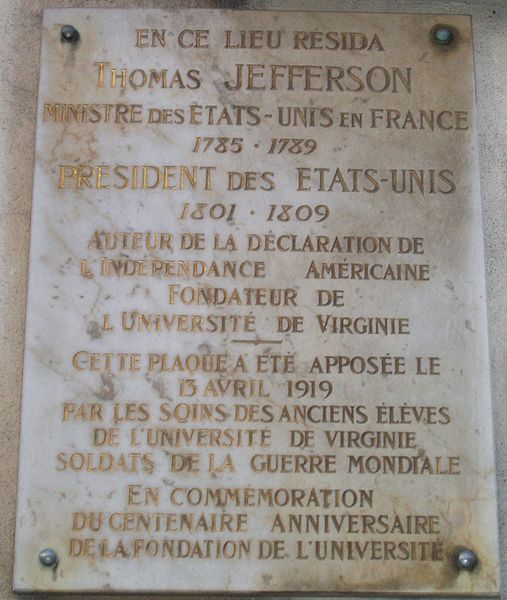Introduction
Every man has two countries-his own and France
Thomas Jefferson
What is known as the oldest international friendship dates to the American Revolution. The romantic version of this story has liberty-loving King Louis XVI sparing no expense to supply George Washington's ragtag rebel army with troops, treasure, supplies and moral support. The more cynical version has France allying with the nascent nation across the sea in order to foil the British (under the principle that the enemy of my enemy is my friend) and secure a share of trade in what was shaping up to be a major market. The truth probably lies somewhere in between, but that was not the concern of Benjamin Franklin (the first U.S. ambassador to France), Thomas Jefferson (who said of Franklin, "No one can replace him; I am only his successor"), John Adams (who went on to be the second U.S. president) and other American expatriates in France. They were too busy concentrating on the task at hand–working hard to secure those royal resources–and getting an immersion experience in French culture.
Extremely instrumental in the accomplishment of that task was Charles Gravier, Comte de Vergennes, Louis XVI's foreign minister, whose support of the thirteen colonies was born of his antagonism toward Britain in general and, specifically, the animosity that the Seven Years' War had left in its wake. The American agents-especially Franklin-had his ear, and thus a direct line to the king. But France's resultant financial backing of America's struggle for independence drained its treasury to such a degree that this is often cited as a contributing factor of its own Revolution
It is said that the American Revolution of 1776 and the French Revolution of 1789 were two faces of the same phenomenon: that much of Western civilization was ready for change, and that these were, in effect, a single revolution that crossed the ocean–just as the U.S. and French labor movements of the 1930s and university revolts of the 1960s would parallel each other. And the tale of this dual revolution must also be set within the broader context of the Enlightenment, with its reverence for science and its passion for intellectual exchange, its rejection of tyranny and its contempt for intolerance. Thus our tour also takes in Voltaire, venerated by the French and Americans alike; Montesquieu, whose thought profoundly influenced the structure of the U.S. government; and the great albeit lesser known Condorcet, whose embrace of revolutionary concepts made him a kindred soul with Jefferson but was also his downfall.
The Founding Fathers in France did not limit themselves to the Left Bank. Jefferson lived on the legendary Champs-Elysées, as the plaque at number 92 attests, and he walked extensively throughout the city, wearing a pedometer to measure his mileage.

Thomas Jefferson's Paris House Memorial
English translation: In this place resided Thomas Jefferson
Minister of the United States to France 1785–1789
President of the United States 1801–1809
Author of the American Declaration of Independence
Founder of the University of Virginia
This plaque was affixed on the 13th of April 1919, by the care of former students of the University of Virginia, soldiers of the World War, in commemoration of the 100th anniversary of the founding of the university
Ben Franklin settled in Passy in a mansion provided and staffed by U.S. sympathizer Jacques-Donatien Le Ray de Chaumont. Now part of Paris, Passy was then a village conveniently situated on the route to Versailles, where Franklin was a familiar figure at court. The first-ever Fourth of July celebration took place at Franklin's Passy residence, co-hosted with John Adams, who was part of Franklin''s delegation. But, as you'll hear and see on our tour, it was on the Left Bank that these luminaries set about establishing their new country. If we liken their work to the building of a house, we might say that Franklin constructed the edifice by creating political and social networks to support and sustain his cause and to obtain financing for the Revolution; Jefferson furnished and decorated it with architectural touches, books and ideas; and John Adams enlarged it through his espousal of the sciences, influenced by advances he witnessed in France.
Though we concentrate on the Left Bank, we'll cast an occasional glance across the Seine to highlight elements indispensable to our story. Along the way we will encounter not only the aforementioned stars of our show but also such famous figures as political theorist Thomas Paine; naval hero John Paul Jones; and John Jay, the first Chief Justice of the U.S. Supreme Court. And in addition to fascinating facts and figures, you'll hear amazing anecdotes as well as readings from the Founding Fathers' own writings. You'll also get answers to questions you didn't even know you had: Who, for example, was the very first American expatriate in France? Why is Paris's statue of Thomas Jefferson located where it is? What oversight saved Thomas Paine's life when he was imprisoned during the French Revolution?
Are you ready? Let's go!
